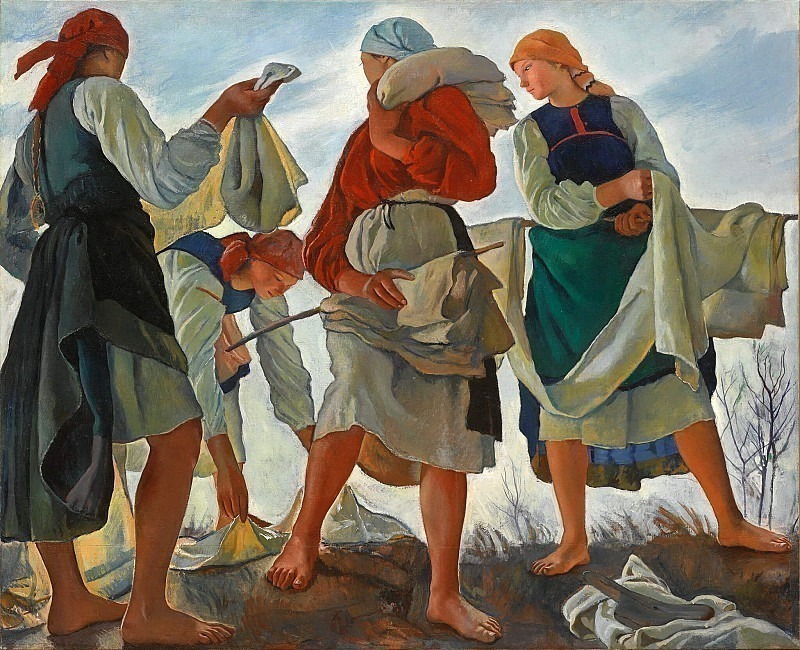Bleaching of canvas Zinaida Serebryakova (1884-1967)
Zinaida Serebryakova – Bleaching of canvas
Edit attribution
Download full size: 2048×1662 px (0,4 Mb)
Painter: Zinaida Serebryakova
Location: The State Tretyakov Gallery, Moscow (Государственная Третьяковская галерея).
Serebryakova was a Russian artist, one of the first women to enter the history of painting. She was born into a very creative family, her father was a sculptor, her grandfather an architect, her mother an artist, one brother also an architect, the other a major contributor to Soviet painting and graphics. In such surroundings, the girl could not remain indifferent to the arts, and after graduating from high school, went to art school.
Description of Zinaida Serebryakova’s painting "Whiting the Canvas"
Serebryakova was a Russian artist, one of the first women to enter the history of painting. She was born into a very creative family, her father was a sculptor, her grandfather an architect, her mother an artist, one brother also an architect, the other a major contributor to Soviet painting and graphics.
In such surroundings, the girl could not remain indifferent to the arts, and after graduating from high school, went to art school. After was a student of Braz, traveled to Italy and France. Of all genres, she preferred portraiture and genre scenes. She painted people she knew, liked to go out into nature and take subjects from the lives of peasants who depended on the land and lived near it until death.
"Whitewashing the Hosta" was her last major work, done, however, at a high level, after many sketches and sketches distinguished by strong compositional differences. On some the girls spread the canvas, on others they carried it, and on others they waited for the right time to pass. The sketches included morning, evening, and noon. At the end, the artist settled on a version in which the girls were just getting to work. They are standing on the bank of the river, four girls in plain clothes.
They do not pose for the portrait, but they are engaged in business - one spreads the canvas, the second serves it, the third unwinds it, the fourth is about to join in the general work.
The composition of the picture is built so that the girls stand as if on the very edge of the sky, the viewer looks up at them, which gives their figures of scale and size. All of them are tall, even by appearance hardy, with pleasant faces, it seems that soon one of them will sing, and the others will catch up, and the riverbank will flow a lingering folk song, telling of love or of grief.
The painting shows the strength of the girls, their freedom, which is not to do nothing, but to give themselves fully to their cause voluntarily and joyfully.
Кому понравилось
Пожалуйста, подождите
На эту операцию может потребоваться несколько секунд.
Информация появится в новом окне,
если открытие новых окон не запрещено в настройках вашего браузера.
You need to login
Для работы с коллекциями – пожалуйста, войдите в аккаунт (open in new window).




















You cannot comment Why?
The painting depicts a group of women engaged in the process of bleaching canvas outdoors. The figures, dressed in traditional peasant attire with headscarves, are actively working with large pieces of white fabric. One woman is holding up a piece of canvas, seemingly inspecting it, while another bends down to spread it on the ground, using a stick. A third woman carries a bundle of fabric over her shoulder, and another is meticulously folding or arranging a length of bleached canvas. The scene is set against a muted sky and a barren, earthy landscape with a few sparse trees in the background, suggesting a rural and perhaps somewhat austere environment. The light is soft but clear, illuminating the white canvas and highlighting the womens movements.
The subtexts of this painting likely revolve around themes of labor, resilience, community, and the cycle of life. The act of bleaching canvas is a laborious domestic task, often performed by women, and its depiction highlights their strength and diligence. The coordinated efforts of the women suggest a sense of communal labor and mutual support, a common aspect of rural life where tasks were shared. The white, bleached canvas can symbolize purity, renewal, and preparation, as it is readied for use in various aspects of life, from clothing to household goods. It might also represent the simple yet essential aspects of a peasants existence, where hard work and basic necessities are paramount. The overall atmosphere, despite the focus on work, can evoke a sense of quiet determination and the enduring spirit of those who sustain their communities through their labor. The hint of bare earth and wintery trees might also subtly point to the cyclical nature of seasons and life, where periods of hardship are followed by renewal, mirrored in the whitening of the canvas.